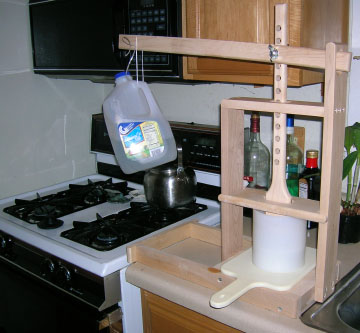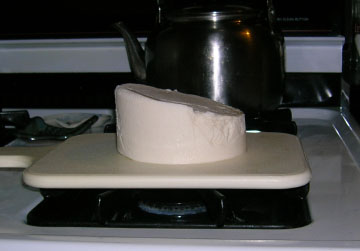A Tale of Two Cheeses
Christmas presents this year included a bunch of cheese making stuff, and I have been eager to give it a try. My Dad gave me a cheese press, and my sister and Leon both gave me books on cheese making. Plus, I bought a couple of things for myself just before the holidays, including an enzyme additive called lipase, which was advertised as giving your mozzarella it’s distinctive Italian flavor. I wasn’t sure what distinctive Italian flavor was, but wanted to find out. So I made a mozzarella on Saturday and a Gouda on Sunday.

The cheese press in action
The lipase was a bit of a disaster. I may have added too much. The curds appeared to give a clean break from the whey, but they were very soft and slippery. The only way I was able to recover them from the cheese pot was to filter them through cheesecloth. The resultant mozzarella was very tasty, however the yield was terrible. I only got about half of what my other batches have made. The mozzarella was soft and did not hold its shape very well. I got more of a cheese pancake. Despite the problems, it was welcome and consumed with gusto when I brought it to dinner at a friend’s house. Still, there’s a lot of room for improvement here. I’ll try using a lot less of the enzyme next time.
I also tried a Gouda, and the results here hold a lot more promise. The author of the cheese book is the same person who provides the kits (and presumably writes the directions) that I have been using previously. So it’s not surprising that the recipe in the book was nearly identical to the recipe in the kit directions. There were, however, two important differences. In the kit, you let the curds settle for about 5 minutes after you cut them before pouring away part of the whey. In the book, you stir gently for 10 minutes before the 5-minute settling. A huge difference: the curds really did settle here, and the entire rest of the recipe was much easier to follow. The other difference is that the kit says to dry the cheese 3 weeks before waxing. The book says dry the cheese 3-4 days before waxing. As the first Gouda came out too dry and crumbly, I intend to wax my cheese later this week.
The only mishap with the Gouda came during the pressing of the curds. The plunger of the cheese press slipped during the final phase of the pressing and I have a lopsided cheese. Not the prettiest, but that problem should be very easy to fix.

Lopsided Gouda- but it tries real hard. I learned from my first Gouda that the cheese will become much yellower during the aging process.
Labels: Cheesemaking


9 Comments:
Such a cheesy posting!
But it looks both exciting to do and delicious. I suspect it will take some time to get the gist of things?
Tell me when you are ready for 'requests'.
A Cheese Press IS A REAL Christmas Present . . . NOW you'll be making Cheese for yourself (& friends) for YEARS....and ALWAYS remember the Christmas you got it. **Question: CAN you get to the Curd Stage and simply save the Curds as is? I DO love that FRESH gouda though............
You have to quit posting about cheese making! I don't need another time and money consuming hobby!!!!
*L*
Very interesting indeed!
The cheese isn't lopsided; the world is!
Lopsided gouda tastes the same as "straight" gouda.
GOUDA for you! What a cool hobby.
I didn't know you could buy cheesemaking equipment. Sounds like I'll stick to store-bought or the kind I scrape off the walls of the caves. I took a cheese-tasting course at an adult ed place here in Boston. We had about 14 cheeses in one night. Yum!
Lopsided cheese is part of the distinctly Italian flavor...remind you of Pisa?
Who is your cheesmaking kit supplier? You've inspired me to look for kits and there are quite a few choices.
I was going to make a cheesey pun, but decided that was not Gouda thing to do.
Mark- You can get to the curd stage and save that. Only problem is, getting to the curd stage is really variable, depending on what kind of cheese you are making. So what you are left with at that point is all over the place in terms of tast and texture (much as the resultant cheeese is).
Post a Comment
<< Home